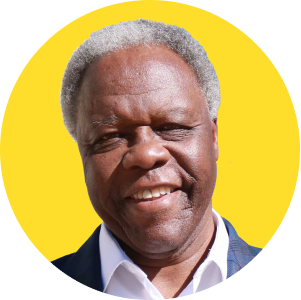Answer the following five questions on housing and homelessness issues to see which candidates for mayor most closely match the future you want to see for Los Angeles. Learn more about this crisis: Understanding LA’s Homelessness Issues.
Question 1 of 5
L.A.’s “anti-camping law” (Municipal Code 41.18) bans people who are unhoused from camping on public property close to locations such as schools, parks, libraries, and underpasses. Should it be kept as is, repealed, or changed?
Candidates who agree with you
Keep it as is
-

Should be kept in place.
Keep it, but expand support for those experiencing homelessness
-

I supported the intent of the anti-camping ordinance passed by the City Council and believe it is unacceptable for homeless encampments to exist near schools and child care centers. What I have a problem with is its district by district, encampment by encampment approach. We need coordinated, citywide leadership to solve this problem, and we need to ensure that housing and services are available for homeless individuals because what I will never accept is simply moving an encampment from one neighborhood to another. That’s not a solution – it’s just passing the buck.
-

I will build 30,000 shelter beds in 300 days with supported services to get people off our streets and provide them with the help they need to get back on their feet. I will also enforce 41.18 to keep people from turning our parks, sidewalks, and bus shelters into encampments.
-

It is not progressive, nor humane, to leave Angelenos to live and die on the streets of our city. That’s why I’ve moved quickly to create enough shelter to house 80% of the homeless in Northeast Los Angeles. The 41.18 Municipal Code only works as-is if there are adequate housing opportunities available, which is why I’ve introduced my 25x25 plan – unanimously supported by the L.A. City Council – to build 25,000 units of housing in the next 3 years.
-

41.18 is a poorly-written partial band-aid with no real solution. We cannot have encampments, but we must have places for people to go. We must regulate and enforce public space, but we must have places for people to go and services they are required to receive.
Change the law, or change how it's implemented
-

The anti-camping law … should be replaced by one that guarantees people in encampments are given access to shelter or housing.
Repeal it
-

It should be repealed. It is a human rights violation.
Question 2 of 5
I believe the primary cause of most homelessness in Los Angeles is…
Candidates who agree with you
A history of racial inequity in housing and wealth
-

The history of 20th century U.S. housing policy is wealth building for white people and wealth extraction for Black people in particular and people of color in general. Until we reckon with this fact, we will never eradicate houselessness.
Economic hardship
-

Economic hardship is the #1 cause cited for the newly homeless, and the housing affordability crisis in L.A. and across the state continues to worsen.
It’s not that simple. It's a complex problem that includes issues like housing costs, addiction and mental illness, racial and social inequity, and a crumbling social safety net
-

This is a complex, multi-faceted problem that requires a multi-pronged, whole of government solution... Nearly 60% of individuals who enter homelessness for the first time cite economic hardship as the primary factor for losing their home. Nearly 50% of unsheltered individuals are either suffering from severe mental illness or substance abuse. 60% of the homeless population are formerly incarcerated individuals who confront barriers to housing and employment because of their backgrounds... Our communities of color are also disproportionately homeless... [And] 1 in 4 homeless youth in LA are former foster youth and 1 in 5 homeless youth identify as LGBTQ.
-

The factors that led Angelenos to experience homelessness are as varied as the people themselves, though there are some leading causes. 1) A severe lack of housing stock, specifically affordable housing. 2) A crumbling social safety net, with housing voucher values in the basement and no real mental health or substance abuse services. 3) A city that works for the very wealthy, while leaving the poor to fend for themselves, often unable to pay rent as costs rise. Still others find themselves financially destitute and on the streets due to medical bills or personal trauma.
-

L.A. is no different from hundreds of American cities. There are lots of contributing factors from mental health to addiction to rising costs of housing, but the #1 immediate source is "one bad day," one mistake that tips someone into homelessness.
-

A triage of problems: housing costs, addiction, and mental illness.
-

Undiagnosed, untreated mental illness, drug addiction, people who cannot survive the high cost of living in L.A., youth who were emancipated out of the foster care program.
Question 3 of 5
Do you agree with Angelenos who say that the large number of people living outside makes the streets less safe?
Candidates who agree with you
Yes, the homelessness crisis makes everyone less safe
-

Homelessness is unquestionably a threat to public safety – it’s unsafe for the housed and the unhoused. The fact of the matter is this: if the tens of thousands of people living in tent encampments lived in houses or apartments instead, all of Los Angeles would feel safer.
-

Homelessness is a humanitarian crisis, a public health crisis, and a public safety crisis all-in-one. Leaving tens of thousands of people to live outdoors on our streets and sidewalks is exceptionally dangerous – especially for our unhoused neighbors. In particular women, protected by nothing but a flimsy tent-zipper, are exposed to all manner of violence and sexual assault. Alternatively, we’ve seen janitors and other workers at Union Station attacked by unhoused individuals living with severe mental illnesses.
-

Yes. It's unsafe on every level. It's unsanitary, it provides hiding places for criminals, it fosters drug use, and it incentivizes bad behavior for communities.
-

The homelessness crisis makes everyone less safe, including those on the streets. It is impossible to address public safety without addressing homelessness.
-

Untreated mental health individuals who are a safety risk to themselves and to the public. Open drug sales and use is contributing to criminal behavior. Drug users are committing crimes on the public and committing crimes on each other. Mentally ill people are a danger to themselves and to the public. Biohazard conditions (used hypodermic needles, methamphetamine, heroin and fentanyl use is a public safety hazard). People living on the streets without proper sanitary receptacles to defecate and urinate on the streets are a health hazard. People living on the streets creates an environment for diseases to grow and spread.
Yes, but most significantly for the people living on the streets
-

It is the most unsafe for the people who have been forced to live on the streets.
It's debatable
-

I think a significant percentage of our homeless crisis is driven by those who are mentally ill and suffer from substance abuse. Whether they directly make our city less safe is debatable, but they do make people feel less safe outside, at our parks, or walking down the street. We need to get people housed, we need to get them services, and for those who can not make rational decisions for themselves due to mental illness we need a Cares Court now.
No
No candidates selected this answer
Question 4 of 5
Who should build housing for the unhoused community: the city or private developers?
Candidates who agree with you
The city. The public/private partnership has resulted in our tax dollars being transferred to the private sector
-

The city! The public/private partnership has resulted in our tax dollars being transferred to the private sector.
Private developers
-

The private sector should build the housing, take the risk for development cost of material and labor. The public sector can agree to a delivery cost and the public sector either buys or leases housing units from the private sector. This will shift the construction risks from the public to the private sector. The private sector can assess the cost, risk and time for delivery and require a reasonable return on their investments for building the housing units.
Both. We need an all-hands-on-deck approach with support from public and private partners
-

Both, because this problem requires an all-of-the-above approach, and that starts with ensuring the city makes it easier for developers to build… I will consolidate all planning, and building and safety functions in a single unit with only one job: fast-track all affordable housing through the development process.
-

Both. We are in a crisis, let's bring every resource to the table and get our unhoused off our streets and back on their feet.
-

The City should be working with all builders to reach our goal of providing enough temporary and permanent housing opportunities to bring our unhoused neighbors indoors. This crisis demands an all-hands-on-deck approach; and with more people falling into homelessness every single day, we need to bring public and private partners together on projects that will bring us closer to our housing goals.
-

We can only build the massive amount of housing our city needs if both the city and private developers work to get the job done.
We need to focus on temporary stabilization, not permanent housing
-

Housing for the homeless should be a temporary stabilization method. We need to stop thinking we have to house the homeless forever. Some will need permanent support, but most do not. We just need to get most people back on their feet.
Question 5 of 5
I believe the biggest barrier to building more affordable housing is…
Candidates who agree with you
Red tape, funding challenges or bureaucratic hurdles
-

As Mayor, I will cut through red tape, expedite approvals, waive development fees and work with the community to build more permanent and affordable housing.
-

[B]uilding in Los Angeles isn’t just expensive, it’s designed to incentivize building high-cost luxury housing over affordable housing. Los Angeles has one of the longest … processes in the country, with most projects taking upwards of 24 months. This timeline creates massive holding costs for builders and, when combined with fees, labor laws, and environmental review challenges, typical projects get delayed for years.
-

Our arcane regulations, insane bureaucracy, and city leaders make it impossible to build any housing, including affordable housing.
-

The high building and permit fees the city of L.A. charges builders.
NIMBYism ("Not In My Back Yard")
-

NIMBYism (the "Not In My Back Yard" mentality).
Restrictive zoning, and having no requirement that new developments include affordable units
-

A lack of leadership with the courage and vision to mandate the inclusion of affordable units in new developments. Additionally, restrictive downzoning under prior city governments has reduced the available space to build affordable housing. As Mayor, I'll reverse both of these trends.
The growing number of private equity firms involved in the process has made securing financing for developers more difficult
-

The amount of private partners who've become overly involved in the process. I've spoken to developers of low income housing who've told me the difficulty that is had securing the funding from the various income streams that are beholden to private equity firms.
- May 23, 2022: Updated the answer from Craig Greiwe on the first question, regarding the anti-camping law.


